I have a patient—let’s call her Sarah—who’s a gym owner and a coach.
Sarah has a client who needs to lose a lot of weight. This client is single, has a stressful job, and is feeling the effects of pandemic isolation.
When the client comes in for her workouts, she doesn’t want to train. She wants to unload.
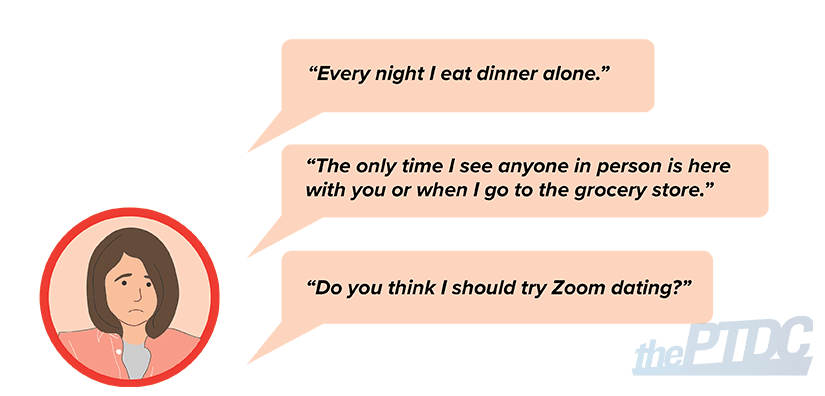
Sarah wants to help, so she ends up playing therapist, listening, empathizing, offering advice.
By the end of the session, Sarah is emotionally drained and feels little progress has been made toward the client’s weight-loss goal. (You know, the thing she was actually hired to help with.)
Personal training is an emotionally demanding job as it is—even more so when clients use sessions to vent about life problems.
- You’re being pushed into a role you’re not trained for (and may not be comfortable with).
- Sessions come and go and fail to produce the targeted results.
- Your client starts to expect the same treatment each session.
- You feel drained, ineffective, and start to dread sessions—setting the stage for burnout.
The key to avoiding this trap? You have to set proper boundaries and develop the skills to keep them intact. I call it a boundary practice.
What are boundaries? Boundaries are roles you play that define appropriate interaction with others.
There are physical boundaries. Remember Dirty Dancing? The scene where Patrick Swayze says to Jennifer Grey, “This is my dance space, this is your dance space. I don't go into yours, you don't go into mine”—that’s a physical boundary.
Most of us have a pretty good sense of physical boundaries. If someone gets too close, you have a visceral reaction. You step back.
But there are other boundaries—like emotional, relationship, or professional boundaries.
When people cross them—by, say, asking too much or being overly needy or critical—you likely still have a visceral reaction. But because you can’t see these boundaries, you minimize or dismiss that feeling.
You think:
That’s not the client being inappropriate. That’s me not being good enough or not saying the right thing.
With personal trainers in particular, boundaries tend to blur. There’s a high bar for trainers today. If you have the impulse to be all things to your clients and be always on call, you know what I mean.
I’ve heard trainers talk about texting and emailing with clients at all hours and trying to be always present on social media. It sounds exhausting.
When you’re a “people helper” (as most trainers are) it’s natural to want to give clients what they want. But if you’re giving more than you’re getting in return, that’s going to drain you. And in the long run, that doesn’t help you or your client.
Boundaries help you define what you’re comfortable with and how you’d like to be treated. Whatever your boundaries are, you should know them—and not be afraid to enforce them with clients.
How to set boundaries with fitness clients: An eight-step guide for personal trainers
1. Define your limits
Before you can set limits, you need to know what your limits are. Based on your pay, what feels reasonable to you? When are you working? When are you off?
Establishing your role can help—think about your personal mission and values.
Why did you become a coach?
What do you want to achieve as a fitness professional?
What are your main objectives in your role?
Having the answers to these questions can help you determine where your professional boundaries begin and end, so you’ll be able to recognize when a client is crossing a line.
Try this: The next time you find yourself listening to your client go on for 15 minutes about their divorce and the stress of a custody battle, see if you can notice whether you’re having a gut reaction—feeling anxious or uncomfortable.
Notice it? Then consider if you’re being pushed outside your role. You might think:
Just sitting here listening is making me feel like I'm not helping, and actually like I'm enabling my client to “cheat” the workout! This is probably outside my role. Let me see if I can gently push us back inside my lane.
2. Tell your client
The best time to introduce your “boundary policy” is from the start—at your initial meeting when you’re going through onboarding paperwork, scheduling, and payment.
This is probably when you’re agreeing on goals and the plan to achieve those goals, right? Perfect segue.
Explain your role and its limits—and how this helps the client achieve their goals:
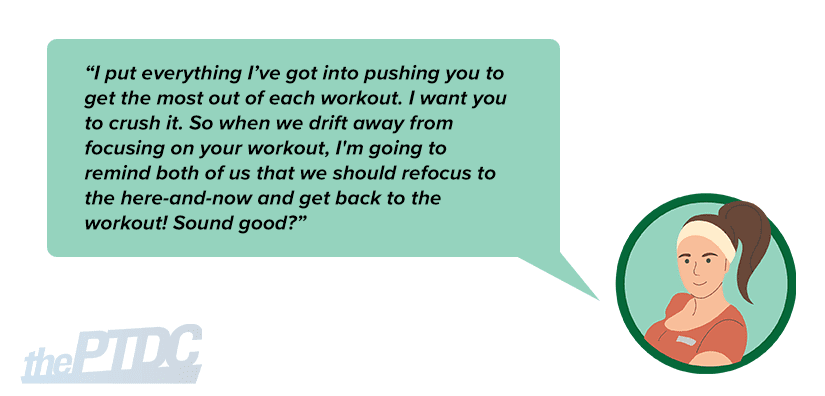
Also talk to your client about their role—the expectations you have for them in terms of focus and effort:
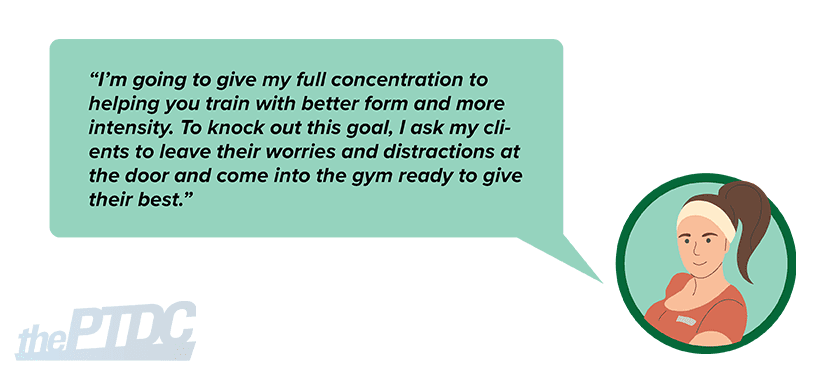
The clearer you can be about your boundaries at the onset, the more effectively you can use them as touchstones should your client push a limit.
If your client is well past the onboarding stage, that’s okay. It’s never too late to set boundaries.
Let’s say you’ve been working with someone for a few months who’s always distracted and wants to talk, and often sends texts and emails between sessions. Start your next session like this:
“Hi Paul, looking forward to getting after it today! Before we start, I just want to check in with you, because I’ve been trying to improve the quality of my services and my business, so I’m putting some new rules in place for myself.
“Moving forward, I’m going to do my best to keep us 100 percent focused on your workout, and I’m going to practice redirecting us if we get off track—you know, like when we fall down the rabbit hole of discussing our favorite IPAs!
“So you might notice that shift, and I want you to know it’s so we can maximize your results. Sound okay?”
3. Learn the four-step “redirect” technique
When a client tries to sway you into listening to their problems—say, during a two-minute rest between sets—try this four-step technique:

- Interrupt. No need to be rude. Simply raise a hand and gently break in: “I don’t mean to cut you off.”
- Validate their feelings. Say, “That sounds really tough. Of course you’re feeling frustrated.”
- Remind them (gently!) of the rules you agreed to and why their fitness goals depend on them. “Like we talked about at the beginning, when you come in for this hour of training, we want to check all that stuff at the door so we can make this a great workout.”
- Redirect your client back to the workout: “The best way I can help you get through your divorce is to help you get awesome results here in the gym and have fabulous workouts. So let's you and I focus on that, okay?”
4. Communicate with compassion
When I teach the “redirect” process, I often get pushback:
“I can’t be so harsh with a client.”
“I’ll hurt their feelings.”
“I’ll get fired!”
They think I’m telling them to be mean. I’m not. Rather, I’m advocating you use authenticity and transparency, with compassion.
What’s the difference?
Let’s say a client tells you they just broke up with their partner and had trouble getting out of bed that morning.
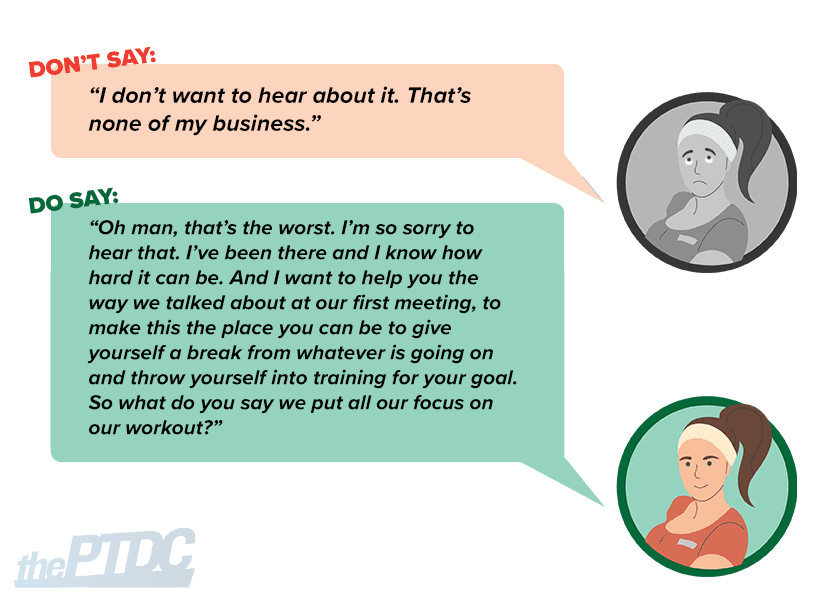
If you’re having a hard time speaking up, just remember you’re actually helping the client do what they said they want to do: train.
5. “Keep the goal the goal”
You’ve probably heard this Dan John quote, right? Well, redirecting is an opportunity to do just that: Keep the goal the goal.
Chances are, that goal is specific and concrete, and has nothing to do with venting about an ex. So highlight that.
Say:
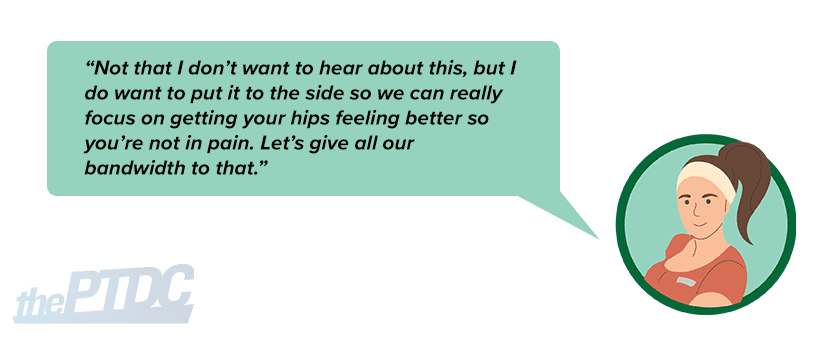
By reinforcing that this is what the client said they wanted, the client keeps a feeling of autonomy (which as you know, is the backbone of sustained motivation).
6. Stay in the posture
In yoga there’s a posture called Utkatasana, or chair pose. While in chair pose, you may feel the urge to stand up or wiggle around, or maybe scratch your ear.

I use this metaphor when I encourage coaches to “stay in the posture” when a client starts pushing a boundary—whether they’re using their session to vent, texting you late at night, or canceling at the last minute.
You may feel the urge to give in to what your client is asking, because you feel you should be accommodating.
It’s good that you’re noticing this feeling, this obligation to a client, but that doesn't mean you have to act on it.
It may mean you have to hold firm to help your client get back on track.
The next time you feel the impulse to give in, take a beat and remember: Stay in the posture.
7. Consult with your colleagues
Still struggling with a difficult client? Talk it through with a fellow coach.
You may hear, “It sounds like you really need to remind them that you're not available for texting on the weekends.”
Or, “Dude, I wouldn't know what to do if they told me every single exercise is terrible and caused a lot of pain. Maybe you should refer them to a doctor.”
In my business, we call this peer supervision. It can provide you with some validation and stress relief, and help you recommit to your boundary practice.
8. Know when to call it quits
If these steps aren’t helping, ending the relationship with a client is an option. Just like in dating, chemistry is important.
I’m not going to be the right therapist for everyone; there are some people I’m just not the right match for.
It’s the same for coaches. Yes, you can bend within a range, but there are going to be ends of the spectrum, and clients you won’t be a good fit for.
If you feel that’s the case, and perhaps a chat with a colleague confirms it, it may be time to move on.
***
When you’re a coach, you have to remember you’re carrying a heavy load. You develop relationships with people who view you as someone who is there to help them.
When you’re coaching, you are being 100 percent present with your client and giving them your bandwidth, which is the most precious resource you have.
Protect it. Build a boundary practice, take care of yourself, and recharge your mind and body every day—so you can enjoy a long, successful journey in an important career.











